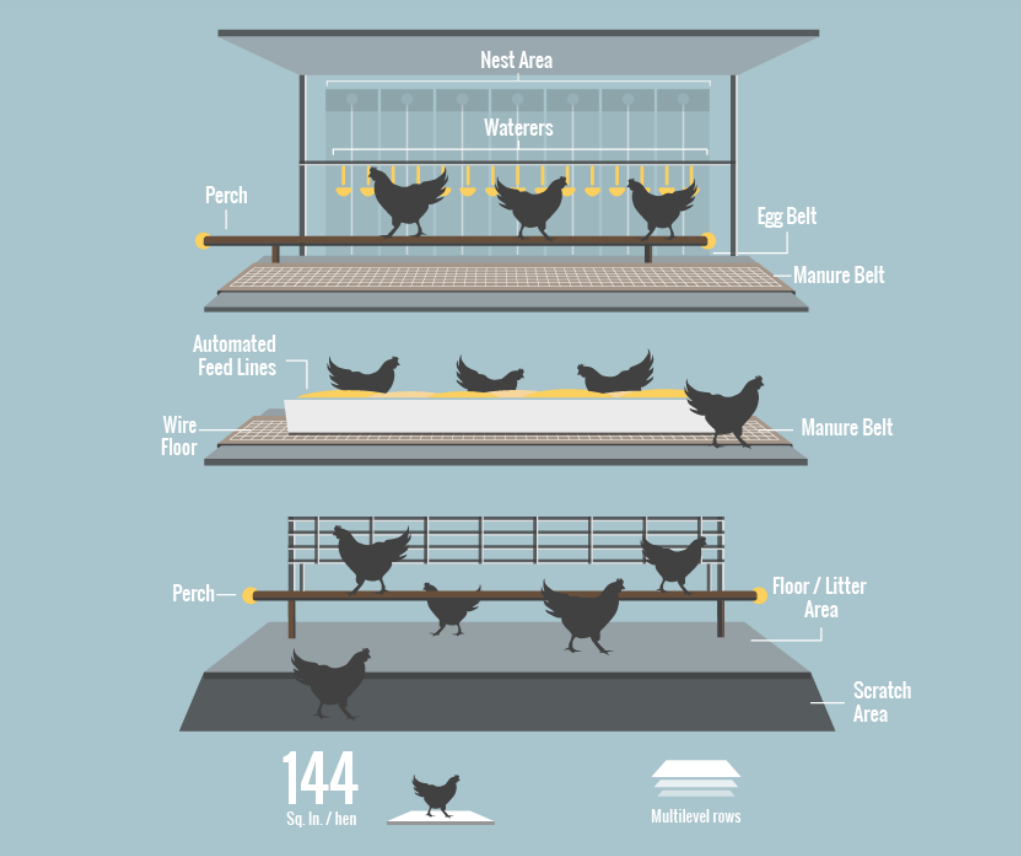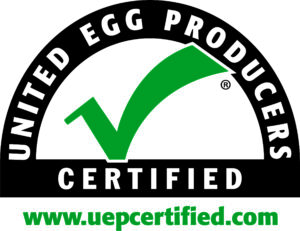Despite what animal rights activists may tell you, today’s standard of animal health and welfare for egg farmers isn’t just good, it’s egg-cellent! In the 1930s and 40s, most of the country’s egg production could be found in your own backyard flock. As the United States population grew and eggs became a staple of the American breakfast, the demand for eggs moved hens indoors and the first set of guidelines for egg farming was written by the United Egg Producers (UEP) in the late 1980s. Decades later, farmers continue to elevate the standards of animal welfare by staying up-to-date on emerging technologies and utilizing basic biosecurity principles. Let’s “crack open” the advantages between the three hen housing types used by a majority of the egg community today: conventional caged housing, enriched colony housing, and “cage-free” aviary housing.
In the 1990s, UEP commissioned a third-party Scientific Advisory Committee on Animal Welfare to research hen needs and provide recommendations for on-farm standards of care. Based on these recommendations, UEP subsequently released two sets of regulations in the early 2000s: the UEP Certified Guidelines for hens housed in conventional systems and the UEP Certified Cage-Free Guidelines. Today, more than 90 percent of eggs produced in the United States come from farms that voluntarily participate in UEP Certified. Their participation means that their farms are subject to independent audits at any time to ensure adherence to these guidelines.
Conventional Housing
Conventional caged housing was first developed to safeguard hens from extreme weather and protect them against predators and disease. During the age of backyard flocks, high hen mortality caused by dogs, foxes and other predators became the norm. Eggs laid in the litter had a higher likelihood of contamination via pathogens in feces and the soil. Diets for egg-layers consisted of whatever lay around the farm, which had the potential to cause diseases or injury. By moving hens into caged systems of housing, egg farmers had the opportunity to monitor individual hen health, provide well-balanced diets tailored to their needs, and protect them from environmental threats. In a conventional caged housing system, hens have free access to feed and water 24 hours a day. Wired flooring allows litter to fall through easily and prevents accumulation. In some cage systems, a conveyor belt positioned underneath the flooring then quickly carries the waste away to be properly managed and potentially recycled as fertilizer for crops. The floor is constructed with a very slight angle so that all eggs laid are gently rolled on to another conveyor belt that carries eggs to be cleaned and packaged. There are typically six to seven hens in a cage, and each is provided 67-86 square inches of floor space to move around and interact with the other hens. This system is typically arranged in multi-level rows, with several tiers of cages stacked up to maximize space.

Enriched Colony Housing
Enriched colony housing was developed to allow hens to interact with one another in larger groups of at most 60 animals. Each hen is granted 116 square inches of floor space in these more spacious pens to move freely. In addition to all the features available in a conventional housing system, colony housing includes enrichment items that allow hens to express more natural behaviors such as roosting, dust bathing and nesting. Enrichment items include perches, scratch pads and designated nesting areas with privacy blinds. These colonies also have the potential to be stacked in multi-level tiers to take full advantage of vertical space in the barns.

Cage-Free Housing

As consumer preference began to shift towards cage-free eggs, some egg farmers transitioned to this housing system to meet the demand. UEP provides guidelines for cage-free housing that encompasses a wide spectrum of variations. Most commonly, cage-free systems consist of open, tiered levels that each meet a different need for hen well-being. Floor space requirements are expected to allow at least 144 square inches per hen, but multi-tiered aviaries provide access to more vertical space than single-level, all-litter floor systems. Just like colony housing, cage-free systems require enrichment spaces to encourage natural behaviors like scratching and roosting. Nest spaces are encouraged to use suitable floor substrate, such as loose litter material, that encourages hens to nest. Because these areas are not recommended to have wire flooring, nesting areas may need to be cleaned regularly to avoid manure accumulation. Perches also must be provided to allow hens to roost at night. At least six inches of linear perch per hen is required for the UEP certification and must be placed appropriately to avoid soiling feed and water sources below.
An eggs-pert look into hen well-being
In 2015, the Coalition for Sustainable Egg Supply conducted a comprehensive commercial-scale study on hen housing in response to consumer concerns regarding animal health and welfare. The objective of the Coalition’s research was “to evaluate various laying hen housing systems and potential impacts on food safety, the environment, hen health and well-being, worker health and safety and food affordability, providing food system stakeholders with science-based information on sustainability factors to guide informed production and purchasing decisions.” Members of the Coalition comprised of representatives from animal welfare associations, academic institutions, non-government organizations, egg suppliers, and restaurant/foodservice and retail food companies. The overview of the results on the Coalition’s website says that the “research found there are positive and negative impacts and trade-offs associated with each of the three hen housing systems.”
An egg-cellent choice for all

“Hens need 100% of our attention for nutrition and healthcare… she will not be able to talk to us. So we need to learn from her behavior what she needs.”
Mohamed Mousa, Michigan egg farmer
Healthy hens produce quality eggs, so it only makes sense for egg farmers to provide the best possible care for their animals. All egg products sold at the supermarket – no matter the housing type used on the farm – are perfectly safe and healthy options for your family!
All posts are the opinion of the author and do not necessarily represent the view of the Animal Ag Alliance.







